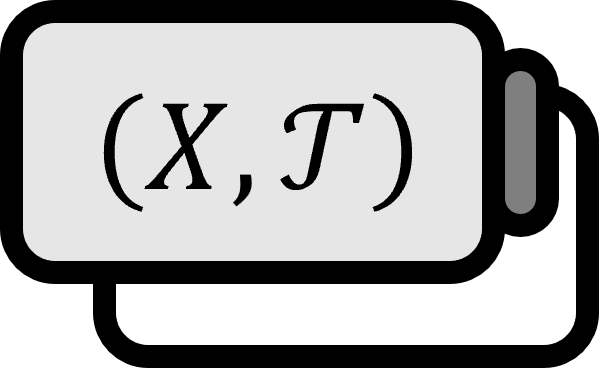Properties of the Interior in Topological Spaces and Subspaces
Theorem
Given a topological space $(X,\mathcal{T})$ and a subset $A,B,A_{\alpha}\subset X\ (\alpha \in \Lambda)$, then:
- $(a1)$: If $A\subset B$, then $A^{\circ} \subset B^{\circ}$.
- $(b1)$: $A^{\circ}\cup B^{\circ} \subset (A\cup B)^{\circ}$
- $(c1)$: $A^{\circ} \cap B^{\circ} = (A\cap B)^{\circ}$
- $(d1)$: $(\cap_{\alpha\in\Lambda}A_{\alpha})^{\circ} \subset \cap _{\alpha \in \Lambda} A_{\alpha}^{\circ}$
Interior of Subspace
Even if it’s the same set, depending on how the whole space is given, it may or may not become an open set. Therefore, to clarify its meaning, the following notation is used.
Assuming a topological space $X$, a subspace $A$, and a subset $B$ are given as $B\subset A\subset X$. then $\mathrm{int}_{X}(B)$ denotes the interior of $B$ in the topological space $X$. $\mathrm{int}_{A}(B)$ denotes the interior of $B$ in the subspace $A$. Also, the following two properties hold:
- $(a2)$: $\mathrm{int}_{X}(B) \subset \mathrm{int}_{A}(B)$
- $(b2)$: $\mathrm{int}_{X}(B)=\mathrm{int}_{X}(A) \cap \mathrm{int}_{A}(B)$
- $A^{\circ}$ denotes the interior of the set $A$.
Proof
$(a1)$
Let’s say $x \in A^{\circ}$. Then by the definition of interior, there exists an open set that satisfies $x \in U \subset A$. Assuming $x\in U \subset A \subset B$, then $x\in B^{\circ}$ is true.
■
$(b1)$
Assuming $A \subset A\cup B$ and $B\subset A\cup B$, then by $(a)$, $A^{\circ} \subset (A\cup B)^{\circ}$ and $B^{\circ} \subset (A \cup B)^{\circ}$ hold. Therefore, $A^{\circ}\cup B^{\circ} \subset (A\cup B)^{\circ}$
■
$(c1)$
$(\subset)$
Let’s say $x\in A^{\circ} \cap B^{\circ}$. Then, $x \in A^{\circ}$ and $x\in B^{\circ}$ are true. Therefore, there exists an open set $U,V$ that satisfies $x\in U \subset A$ and $x\in V \subset B$. Since the intersection of open sets is also an open set and $x\in (U\cap V) \subset (A\cap B)$, then $x\in (A\cap B)^{\circ}$.
$(\supset)$
Assuming $A\cap B \subset A$ and $A \cap B \subset B$, then by $(a)$, $(A \cap B)^{\circ} \subset A^{\circ} $, and $(A \cap B ) ^{\circ} \subset B^{\circ}$ hold. Therefore, $(A\cap B)^{\circ} \subset A^{\circ}\cap B^{\circ}$ is true.
■
$(d1)$
Let’s say $E=\cap_{\alpha\in\Lambda} A_{_\alpha}$. Then for all $\alpha$, $E \subset A_{\alpha}$ is true. Thus, by $(a)$, for all $\alpha$, $E^{\circ} \subset A_{\alpha}^{\circ}$ is true. Therefore, $(\cap _{\alpha \in \Lambda }A_{\alpha})^{\circ}=E^{\circ} \subset \cap_{\alpha \in \Lambda}A_{\alpha} ^{\circ}$
■
$(a2)$
Let’s say $x\in \mathrm{int}_{X}(B)$. Then by the definition of an interior point, there exists an open set $U$ in $X$ that satisfies $x \in U \subset B$. Then, $U \subset B \subset A$ and an open set $U$ in $X$ that satisfies $U=A\cap U$ exists, so by the equivalence conditions for an open set in a subspace1, $U$ is an open set in the subspace $A$. Therefore, an open set $U$ in $A$ exists that satisfies $x\in U \subset B$, so $x \in \mathrm{int}_{A}(B)$
■
$(b2)$
$( \subset )$
Since $B\subset A$, by $(a1)$, $\mathrm{int}_{X}(B) \subset \mathrm{int}_{X}(A)$ is true. Also, by $(a2)$, $\mathrm{int}_{X}(B) \subset \mathrm{int}_{A}(B)$ is true, so $$ \mathrm{int}_{X}(B) \subset \mathrm{int}_{X}(A) \cap \mathrm{int}_{A}(B) $$
$( \supset )$
Let’s say $x \in \mathrm{int}_{X}(A) \cap \mathrm{int}_{A}(B)$. Then there exists an open set $U$ in $X$ that satisfies $x \in U \subset A$ and $ x \in V \subset B$, and an open set $V$ in $A$. Since $V$ is an open set in $A$, by the equivalence conditions for an open set in a subspace2, an open set $U^{\prime}$ in $X$ exists that satisfies $V=A\cap U^{\prime}$. Thus, for the open set $U\cap U^{\prime}$ in $X$, $$ x\in U\cap U^{\prime} \subset A\cap U^{\prime} =V \subset B $$ Therefore, by the definition of an interior point, $x\in \mathrm{int}_{X}(B)$
■
